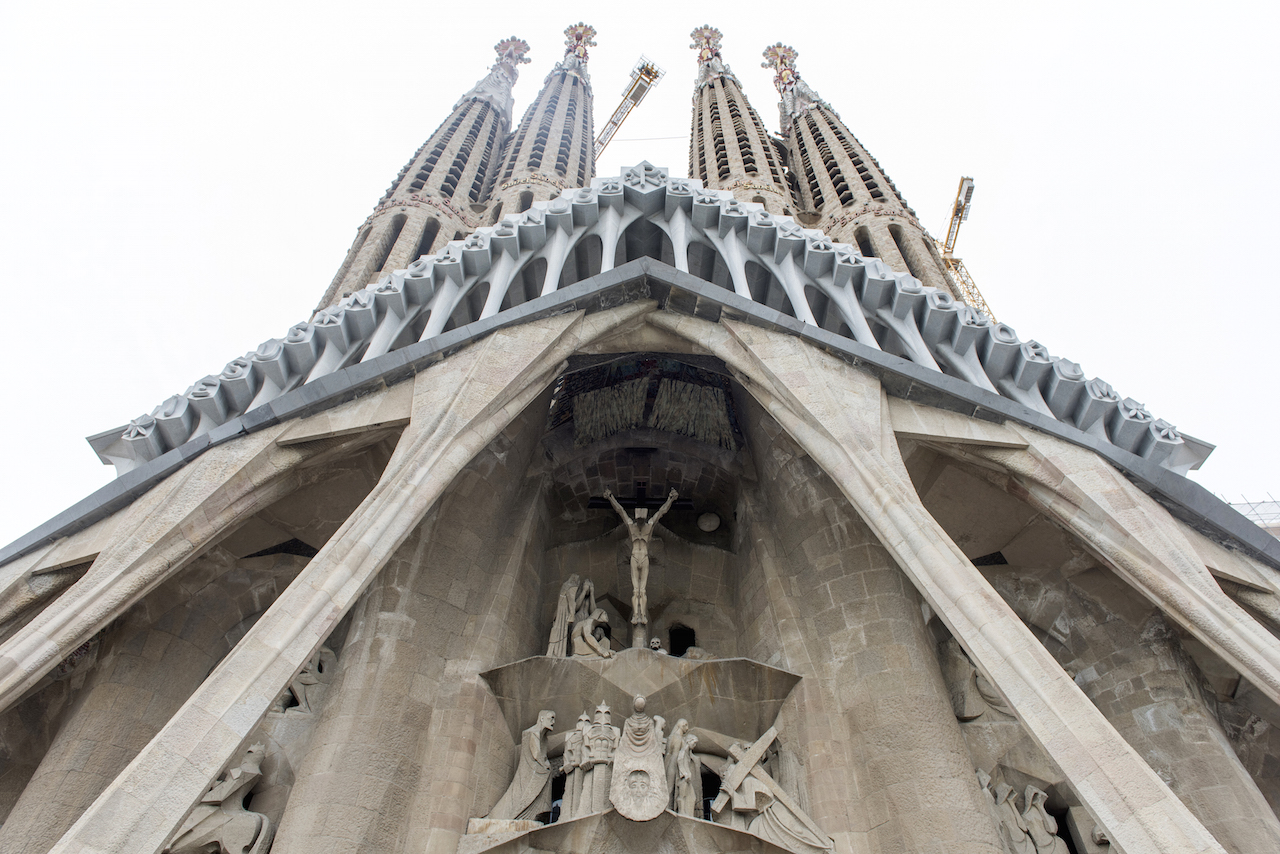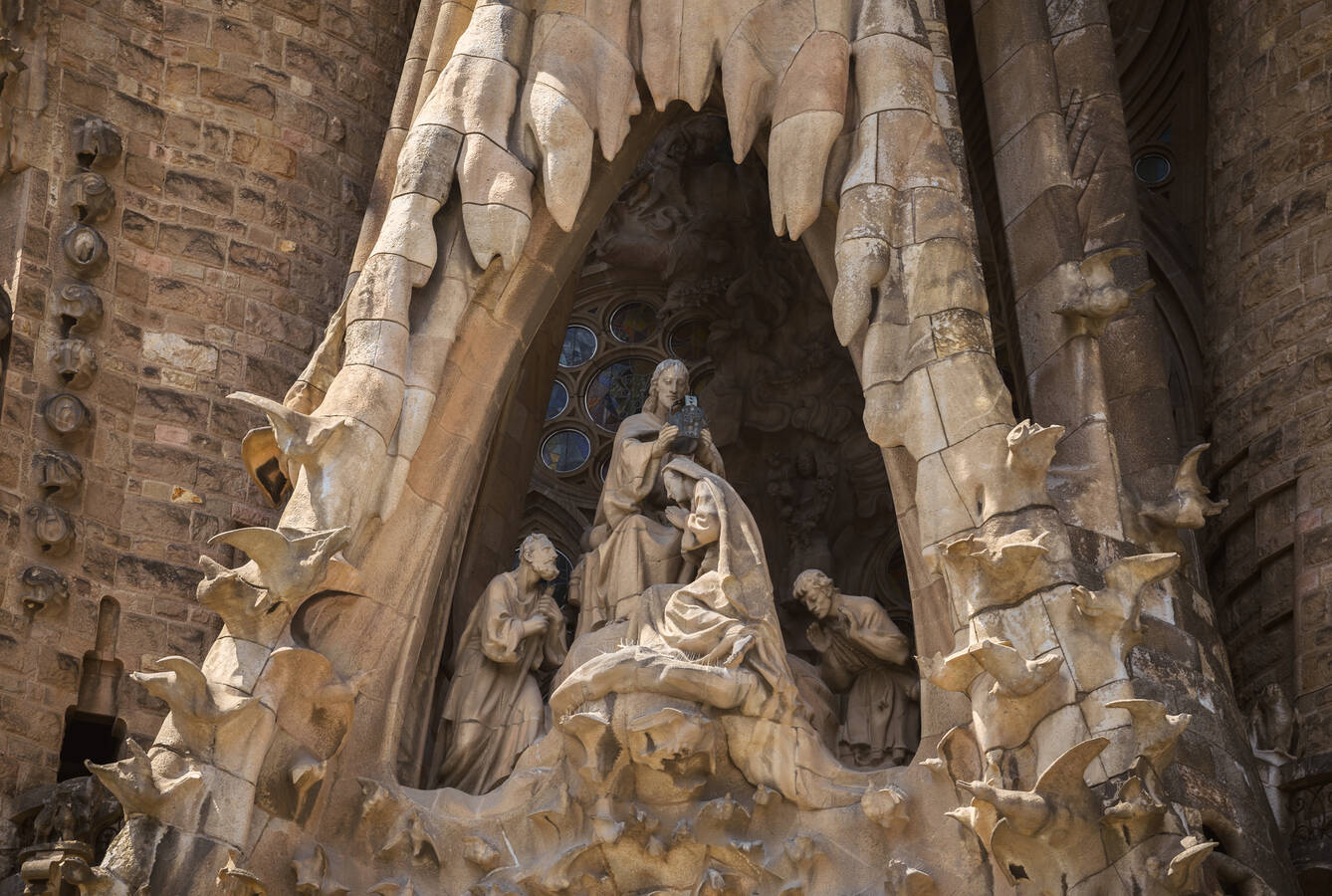We took the subway to Sagrada Família, which strengthened my first impression of Antoni Gaudí’s renowned cathedral from pictures: It looks like a termite mound. But as we climbed up from the earth and beheld its muddy towers stretching beyond us into the Barcelona sun, we became the termites. Gaudí didn’t mean this as an insult, for God loves termites too, yet the Puritan in me resented the suggestion.
The cathedral’s northeast facade sprouted upon approach into a cluster of saints, tangled in Catalonian flora rather than neatly stacked, as in most Gothic portals. It brought to mind the frontispiece from Hobbes’s Leviathan, the big king made of wee people. Like Hobbes, Gaudí was a royalist, “the very opposite of a cultural subversive,” in Robert Hughes’s words, who built Sagrada Família to “atone for the sins of modernism and the ‘excesses’ of democracy.”
Not long after Gaudí’s death in 1926, modernity resisted a chance for revenge during the Spanish Civil War. Anarchists ransacked yet spared the cathedral, citing its artistic value and Gaudí’s popularity in Catalonia. Instead they taunted priests and fascists by hanging their banner between its towers. George Orwell, lifelong foe of what he called “political Catholicism,” felt that Sagrada Família was “one of the most hideous buildings in the world,” that “the Anarchists showed bad taste in not blowing it up when they had the chance.” Gaudí probably would have responded, as he once remarked, that “democracy is the rule of ignorance and stupidity.”
Gaudí built Sagrada Família to “atone for the sins of modernism and the ‘excesses’ of democracy.”
So as I disentangled the facade’s bed of tendrils, leaves, chicken and geese, I found its saints lounging like lords rather than ascetics, raised by two pillars on the backs of a tortoise and a sea-turtle with peasant faces, their mouths gawking in pain and ecstasy. Even the titular holy family at the heart of the Nativity facade—Mary, Joseph and baby Jesus—are flanked by an ox and a donkey with dullard grins. When completed, the cathedral’s two main towers will raise Christ and Mary high above the Barcelona skyline as the earth’s clear king and queen. The ignorant and stupid loafers on the Nativity facade are happy with these royals, everyone birthing and vegetating and wriggling.
I did not trust Sagrada Família. It wasn’t just gaudy (though it was also that), nor merely goofy (that grinning ass), but an epileptic threat that risked overwhelming any kind of sensual order. Jonathan Glancey warns that the work “may be difficult for puritan eyes,” which squint for straighter lines and cleaner consciences, and the squirming termite mound did give me an iconoclast’s itch.
But truth be told, my suspicion was at least partly a reaction against temptation. The Nativity facade charmed me, and I know that Gaudí intended this. I imagined him leaning out from one of the towers and laughing down: “Have I laid it on too thick, poor Puritan, fellow mite?”
•••
The charm was especially potent on someone reared in Barcelona’s opposite, a cold corner of Iowa on the edge of the Great Plains—flat, windswept and Catholic-free, if my ancestors would have had their say. After the U.S. military forced out the area’s original Siouan tribes, the region became a hub for Dutch Calvinists like my great-grandparents, pilgrims who had left Holland for cheap land and spiritual purity as the national church fell like Lucifer into liberalism. They straightened the landscape to fit their theology, glorifying God as they plowed each inch of tillable prairie into pin-straight rows of corn and soybeans. (My father, a farmer and crop-duster, plants and sprays his crops with a GPS system that keeps tractors and planes perfectly plumb.) The region’s architecture similarly subjugates style to the calculations of conscience and purse. Newer homes are built in the nondescript “neo-eclectic” style of American suburbs or, if older, plain ranch and farmhouse style, just as municipal and business structures are often simple tin and wood-frame “Morton Buildings.” More important than a home’s style or status is its affordability and cleanliness. Straight lines abound.
In her first trip to Europe, Harriet Beecher Stowe fell in love with Catholic splendor against her better judgment.
As we enter the quincentenary of the Reformation, many still trace the best and worst facets of modernity to the lasting legacies of Luther and his more eager Puritan enthusiasts, but rarely in terms of architecture. This is an ironic omission for a movement that drew much of its energy from stripping down churches. Consider William “Basher” Dowsing, the Puritan soldier who carried out parliamentary orders in 1643 to make an iconoclast’s pub-crawl through nearly 300churches. “We brake down about a hundred superstitious Pictures,” he reflected in his meticulous record of buildings purified, “and 200 had been broke down afore I came. We took away 2 popish inscriptions with Ora pro nobis; and we beat down a great stoneing cross on the top of the church.” For better and worse, the American landscape owes much to Basher.
This landscape has in turn prompted mixed reactions when American Protestants first experienced Catholic Europe. In her first trip to Europe, for instance, Harriet Beecher Stowe fell in love with Catholic splendor against her better judgment. A member of the renowned Beecher clan of preachers, she celebrated her Puritan roots as the origins of American democracy and despised “the rottenness of the Romish system”; but when she experienced its baroque altars, rich galleries and especially its cathedrals, Stowe suspected that her heritage had starved her aesthetically. “With all New England’s earnestness and practical efficiency,” she confessed, there is “a crushing out of the beautiful, —which is horrible. Children are born there with a sense of beauty equally delicate with any in the world, in whom it dies a lingering death of smothered desire and pining, weary starvation. I know, because I have felt it.”
•••
I began to feel similarly as we left the squirming Nativity facade and came to the southwest Passion facade, its spatial and stylistic opposite. Christ’s fingers are sharp-edged as he carries his cross or clenches a pillar while being whipped. There are no animals other than a square dog, a snake by Judas and a Picassoan steed among orthogonal soldiers. The bodies of Mary and Mary Magdalene are compressed into rectilinearity as they weep under a Christ with concave ribs and face, stretched on the cross at the facade’s apex. Framing everything is the most striking structural element, pillars that Gaudí has tilted inward and twisted ever so slightly into paraboloids. The impression is that of strained tendons or fleshless ribs. It is as if Gaudí aims to torture the Puritan desire for straight lines. “Here they are, then,” he says with an impish grin, just before lightly warping them. The result is crucifying and the message is clear: Sin, for Gaudí, is humanity’s hubristic efforts to straighten things out.

I revolted in vain as the Passion facade swallowed me up and pulled me down into the dark outline of a leviathan’s ribcage, threatening to dissolve me into a skeleton myself. The experience was horrifying and just as garish as the Nativity facade, laid on so thick that it suffocated. But it fit a horror I have often felt myself, either at funerals when I can’t prevent myself from imagining the departed decaying underground, or when I read the news and encounter some new instance of humanity’s breathtaking capacity for cruelty.
Gaudí perfectly provokes us Puritans.
As it devoured me, the Passion facade in turn prompted me to reach back in a panic for the Nativity, whose excess appeared warranted when counterpoised against such suffering and death. This new impression resembled the feeling I have after funerals—especially if children are present—when the initial horror of death has passed and the family begins to share food and stories. My gratitude for life momentarily washes away the drive to straighten things out.
Gaudí perfectly provokes us Puritans. By joining the wriggling Nativity facade to the writhing Passion facade, Sagrada Família is above all excessive. It is not “transgressive,” as we like to call daring art today, precisely because it laughs away lines rather than crossing or smashing them. This is why Gaudí’s masterpiece can feel so strange to modern eyes, inevitably influenced by the Puritanical facets of the present. The cathedral palpitates and undulates in the middle of modernity, making one itchy with its surplus of life and death. Is this what beauty means in a time of disenchantment, all of our excesses reinvested into straighter lines?
•••
We had passed from cradle to grave, so all that remained was to go inside. Instead of buttresses, the interior rose up on slender white columns that curved and branched like trees. Red and orange light streamed through its boughs from the southwest windows, blue and green from the northeast. Was it dead rock or sappy wood, this birch forest bathed in autumn twilight? The disorientation returned. Outside was in. The vault budded with blossoms and leaves, then burned into stars. Stones came to life, twisting and branching and rolling. For a moment, before getting on with straightening out modernity, I was reeling.











Don't pay any attention to this author on Gaudi or the Sagrada Familia. Go for yourself to see one of the most magnificent creations in history. The author chose a couple unappealing photos, I guess on purpose. We were there as part of a pilgrimage in October (Fatima to the Sagrada Familia) and everyone was in awe of the place when we got there.
Gaudi is known as God's architect and yes straight lines are out because straight lines are not found in nature. In all of Gaudi's works and there are several in Barcelona, he uses nature to shape his buildings and structures. Don't miss La Predrera which became the inspiration for George Lucas' Star War characters. It is the second best Gaudi attraction especially the roof and the tour at night and the museum in the attic floor which explains why there are no/few straight lines.
The best way to introduce yourself to the Sagrada Familia is to google "Sagrada Familia 60 minutes Pope Benedict" There is a long Youtube video from the CBS show of the dedication Mass with an explanation of what happened to bring this building to where it is today. You can find other videos of it too. It is currently the most visited place in Spain and dominates the skyline of Barcelona.
There is a Sunday Mass there which anyone can attend. It is considered a parish church. The Mass was at 9:30 and they recommend you get there at 8:30 to make sure you get a seat near the altar. The priest spoke three different languages based on who is attending. They asked us before entering where we were from and they chose people from the line as readers and the gift bearers.
Been there twice. Hope to be around when they complete it. It is targeted for the 100th anniversary of Gaudi's death in 2026.
Besides the Sagrada Familia, Barcelona is the most fun city in Europe. Obviously an opinion but shared by nearly everyone I meet who has been there.
Tried to add the link but it was caught up in the software moderation. Google Sagrada Familia 60 minutes and then choose the youtube link. It is well worth the trouble.
The Author now knows why the Counter Reformation utilized architecture and decoration to such good advantage: great voluptuous curves and idealized humanity in the Northern Churches and bloody realistic humanity in the Southern Churches. A celebration of the emotion of connecting with the Redeemer. ALL contrasted sharply with the Reformation's progression to the rigid lines, colorless glass and wood structures the Author's emotion lived in.
Sagrada Família is a wonder of our times. Antoni Gaudí is a genius. Praise the Lord.